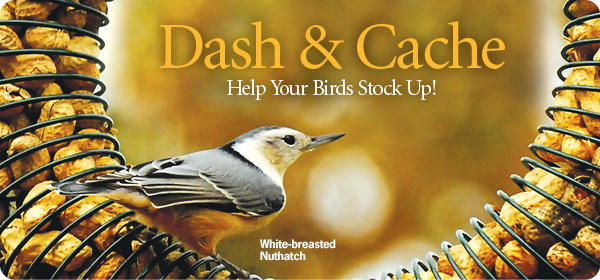Being Seasonally Savvy: Cashing in on Caching
Right now chickadees, nuthatches, titmice and jays are hiding food to retrieve and eat later this season. This behavior is called “caching.” Caching helps birds survive during bad weather and when food sources are low. These birds can store hundreds of seeds a day. Each seed is placed in a different location and they generally remember where each one is, even months later.
By providing a foundational feeder filled with their favorite foods, you can help your birds with their caching needs. Recent research has shown that a consistent and reliable source of food helps birds to build body fat reserves, reduces their physiological stress and helps to maintain a healthy body condition.
Chickadees prefer to cache black oil sunflower seeds; often eating a small portion before hiding it in and under bark, dead leaves, knotholes, clusters of pine needles, gutters, shingles and in the ground. Chickadees caches more in the middle of the day when visiting feeders.
Titmice are rather particular. They choose the largest sunflower seeds available to eat and cache. Titmice and chickadees like to cache seeds within 130 feet of bird feeders; your yard or a neighbor's yard. Often, they tuck seeds into the bark and crevices of a wood pile or on a large branch. They even cache them under mulch in a garden.
Nuthatches prefer heavier sunflower seeds over the lighter ones. Be sure to have some sunflower chips in your blend, too, as they like these 25% more than ones in the shell. They prefer to hide foods on deeply furrowed tree trunks and the underside of branches. Nuthatches are also known to hide seeds under a shingle or behind wooden siding.
Jays love to cache peanuts, sunflower seeds, acorns and pine nuts. They are especially fond of peanuts in the shell. They bury them in the ground and are known to cache about 100 in a day; emptying a feeder in no time. Watch for them make repeated trips to your feeders (or an oak or pine tree) and fly off. They can travel up to two miles to bury their nutritious treasure.
Create an Autumn Habitat For Your Birds
Autumn is a time for sweet memories of falling leaves and aromas of pumpkin spice. As much as we look forward to traditions, birds look forward to the consistent things in our yards. Fall is the perfect time to advertise to the birds that they can rely on our yards as part of their winter habitat territory.
Leave the Landscape: Leave spent plants standing to provide natural food sources and protective cover for the birds. Sparrows will flit to the top of the plants and “ride” them to the ground to feed on the seeds. Juncos and towhees will scratch the ground for dropped seeds. Other birds can find morsels of native insects overwintering in the dormant garden spaces.
Take Stock of Feeders: During winter, birds need high calorie foods to keep their little bodies warm, especially during cold nights. Fall is the perfect time to clean, repair or install new feeders before winter arrives.
A Feeding Foundation: Birds are always looking for food; whether they are eating it or not. Have at least one foundational feeder available now that dependably provides food and does not have to be filled very often. Help your birds know your food is reliable and ever present for them; especially when the weather turns nasty.
Provide Shelter: Cold winds strip heat from birds very quickly. Birds will seek refuge from the wind in dense vegetation, natural cavities, brush piles or roosting boxes. Roosting boxes provide birds with a warm, dry location that can help protect them from cold, nasty winter weather. Autumn is a convenient time to convert your nest boxes into roosting boxes by temporarily plugging the ventilation holes to help trap heat inside the box.
Offer Water: Birds need water in winter to maintain their feathers for effective insulation. Take time now to set up a heated bird bath or add a heater to your existing plastic, metal or stone bird bath. This will help make some water available even on the coldest day.



